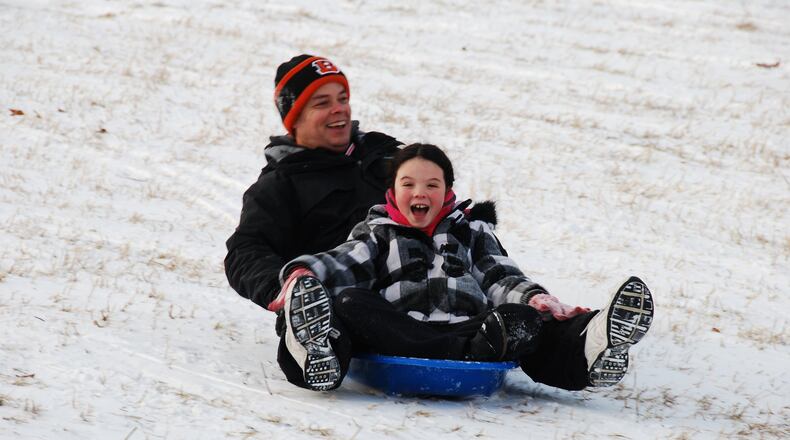>>The best places to go sledding in and around Dayton
A cherished seasonal pastime, sledding can be fun for the entire family.
And some quality time with a toboggan can also provide a good workout as, according to the National Personal Training Institute, an hour of sledding has the potential to burn more than 400 calories. While gravity does much of the work on the way down, repeatedly walking uphill carrying your sled or pulling your little snow lover on a toboggan can torch quite a few calories and work large muscle groups.
While a carefree afternoon in the cool, crisp winter air might be the goal, it takes some planning and preparation to have a safe and fun-filled day.
WHERE TO GO
Location, location, location. Finding the right place to sled can make all the difference.
“You need to find a safe area, especially one where you can stop safely,” said Jordan Hart, Five Rivers MetroParks outdoor recreation program specialist.
>>4 places to go snow tubing near Dayton
A clear sledding path means no trees or stumps in the way and no creeks or streams at the bottom of the hill.
“You also want to have a safe area to climb up the hill – not in the path of those coming down,” Hart said.
Community parks and golf courses are popular sledding locations. The MetroParks have designated sledding locations in three of their parks – Englewood, Germantown and Taylorsville.
WHAT TO WEAR
Layering is the key for outdoor, cold-weather activities.
“That way, if you get hot, you can take a layer off,” Hart said.
Follow the 3 Ws of winter wear – wicking, warm and weather – when it comes to layers. The wicking layer is a synthetic material worn closest to the body to get rid of sweat. The warm layer is for insulation – think fleece or down. And, finally, the outermost weatherproof layer to block wind and water.
>>5 things you should know about the Great Blizzard of 1978
A hat and insulated waterproof gloves or mittens are a must, but leave the scarves at home.
“Scarves can be a hazard when sledding,” Hart said.
Wool socks are superior to cotton, which retains moisture. Appropriate footwear should be well-insulated, but not so snug that there isn’t wiggle room for your toes.
WHAT TO BRING
It might seem like common sense, but sledding is safest on a sled – not a cafeteria tray, trash bag or lid from a plastic storage bin.
“And it’s best to sit upright, in a forward-facing position,” Hart said. “That way you can see potential hazards and roll off to the side if you need to.”
A few summer essentials are also winter must-haves.
“You should drink plenty of water to stay hydrated,” Hart said. “Even when it’s cold, you can still break a sweat.”
>>Who is Lily? The real story behind the name of one of Dayton’s favorite restaurants
And summer isn’t the only time you can get sunburn. Sun reflects off the snow in much the same way as it reflects off the water, so don’t forget the sunscreen and sunglasses.
An extra hat, gloves and socks, just in case – along with a dry change of clothes – can make for a more comfortable ride home after you’ve had enough snowy fun.
FIVE RIVERS METROPARKS SLEDDING SITES
Englewood MetroPark
100 E. National Road, Vandalia
The sledding hill is located along the dam in the West Park. It’s steep, but there’s lots of room for multiple launches for races or stunts.
Germantown MetroPark
6206 Boomershine Road, Germantown
The big hill at Germantown is well worth the drive. Located 20 minutes from Dayton, it is arguably the best sledding hill in the MetroParks.
Taylorsville MetroPark
1200 Brown School Road, Vandalia (Entrance is on the east side of Brown School Road, south of U.S. 40)
Grass turf, a few bumps, no obstacles and a gentle grade make for safe, long-distance sledding. The hill slopes only 30 degrees and you slide about 400 or 500 feet before stopping.
About the Author





